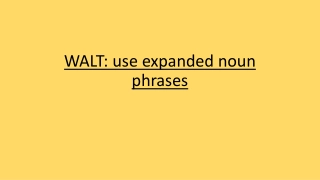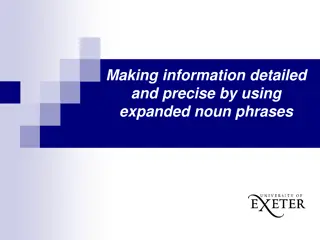Exploring Descriptive Detail Through Expanded Noun Phrases
Delve into the art of using expanded noun phrases for descriptive richness in writing, as showcased through authentic texts and engaging discussions. Uncover how these linguistic choices bring life to descriptions, enhance imagery, and spark creativity in readers' minds.
Download Presentation

Please find below an Image/Link to download the presentation.
The content on the website is provided AS IS for your information and personal use only. It may not be sold, licensed, or shared on other websites without obtaining consent from the author. Download presentation by click this link. If you encounter any issues during the download, it is possible that the publisher has removed the file from their server.
E N D
Presentation Transcript
Using expanded noun phrases for descriptive detail
LEAD Principles PRINCIPLE LINKS EXPLANATION RATIONALE To establish a purposeful learning reason for addressing grammar, and connect grammar with meaning and rhetorical effect Make a link between the grammar being introduced and how it works in the writing being taught To avoid writing lessons becoming mini- grammar lessons, and to allow access to the structure even if the grammar concept is not fully understood To integrate reading and writing and show how real writers make language choices EXAMPLES Explain the grammar through examples, not lengthy explanations AUTHENTIC TEXTS Use authentic texts as models to link writers to the broader community of writers To promote deep metalinguistic learning about why a particular choice works, and to develop independence rather than compliance DISCUSSION Build in high-quality discussion about grammar and its effects
Authentic text Noticing Details in a Text the shop from nowhere the mysterious building bricks the colour of midnight bricks that shimmered and sparkled under the glow of the gas streetlamps the fine golden gate a golden gate so fine and intricate that some wondrous spider might have spun it a glimpse of movement through the darkened windows a glimmer of movement in the entranceway the door to a world of breathtaking magic and looming danger Examples Discussion Look at the noun phrases that are used to describe the Nowhere Emporium. How well do they match the picture on the front cover of the book? From the way it s described, would you want to go inside this shop? What objects do you think you might find inside?
Noticing Details in a Text Examples The shop was indeed built from bricks the colour of midnight, bricks that shimmered and sparkled under the glow of the gas streetlamps. Blocking the doorway was a golden gate so fine and intricate that some wondrous spider might have spun it. Over the windows, curling letters spelled out a name: The Nowhere Emporium. There was a glimmer of movement in the entranceway and, a ripple of excitement passed through the crowd. And then silence fell a silence so deep and heavy that it seemed to hang in the atmosphere like mist. The shop s door swung open. The fine golden gate turned to dust, scattering in the wind. The air was suddenly alive with a hundred scents: the perfume of toasted coconut and baking bread; of salty sea air and freshly fallen rain; of bonfires and melting ice. How much of the descriptive detail is created through expanded noun phrases? Can you see where these are placed within a sentence? How well do the noun phrases help you to visualise the emporium, imagine what is inside it and understand how the crowd react to it? Discussion Links
Verbalising the Grammar-Writing Link A crucial element of the LEAD principles is helping writers to think explicitly (metalinguistically) about the choices they make. As a teacher, you need to support this by being crystal clear yourself about how you verbalise the link between a grammar choice and its effect in a particular text/context. Then express this in student-friendly language, as below. Verbalisation to share with students: When you are describing a scene in narrative, you can help your reader visualise it by describing it in detail. You might choose to use expanded noun phrases that provide a detailed description. Choose your noun phrases carefully!
Invent and label objects in a cabinet of curiosities an ancient cabinet of curious wonders from around the world an antique clock with a cracked glass face a specimen jar that contained a small wooden cross a china doll s head with piercing blue eyes a miniature silver key so small that an elf might have fashioned it























